LG G2 and MSM8974 Snapdragon 800 - Mini Review
by Brian Klug on September 7, 2013 1:11 AM EST- Posted in
- Smartphones
- LG
- Mobile
- LG G2
- Android 4.2
- MSM8974
- Snapdragon 800
GPU Performance
Snapdragon 800 features Qualcomm's Adreno 330 GPU. Qualcomm hasn't stated publicly how Adreno 330 compares to Adreno 320 featured in Snapdragon 600, but it's almost certainly a larger GPU. The 8974 implementation in LG's G2 clocks the Adreno 330 GPU at a maximum of 450MHz, yet we see better performance than the 450MHz Adreno 320 in Snapdragon 600 - lending credibility to the idea of having more execution resources. There's also an 8974AB variant which includes a 100 MHz bump in GPU clocks up to 550 MHz.
3DMark
3DMark for Android features the Ice Storm benchmark and uses OpenGL ES 2.0. Ice Storm is divided into two graphics tests and a physics test. The first graphics test is geometry heavy while the second test is more pixel shader intensive. The physics test, as you might guess, is CPU bound and multithreaded. The overall score takes into account both graphics and physics tests. The benchmark is rendered to an offscreen buffer at 720p/1080p and then scaled up to the native resolution of the device being tested. This is a very similar approach we've seen by game developers to avoid rendering at native resolution on some of the ultra high resolution tablets. The beauty of 3DMark's approach here is the fact that all results are comparable, regardless of a device's native resolution. The downside is we don't get a good idea of how some of the ultra high resolution tablets would behave with these workloads running at their native (> 1080p) resolutions.
For these benchmarks we stuck with the default presets (720p, normal quality).
3DMark performance generally fell very close to Qualcomm's MSM8974 MDP/T, with one exception. The CPU bound physics tests had the G2 far lower down the list than I would've expected. Given that test is mostly a multithreaded CPU benchmark, it's entirely possible that the G2's thermal/frequency governors are set more conservatively there. The performance gains elsewhere over Snapdragon 600/Adreno 320 are huge, but 3DMark can be very influenced by CPU performance so it's not clear how much of this advantage is due to Adreno 330 or Krait 400.
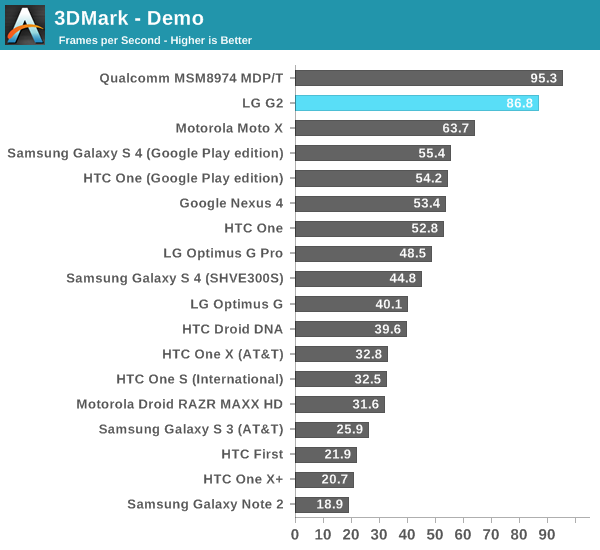
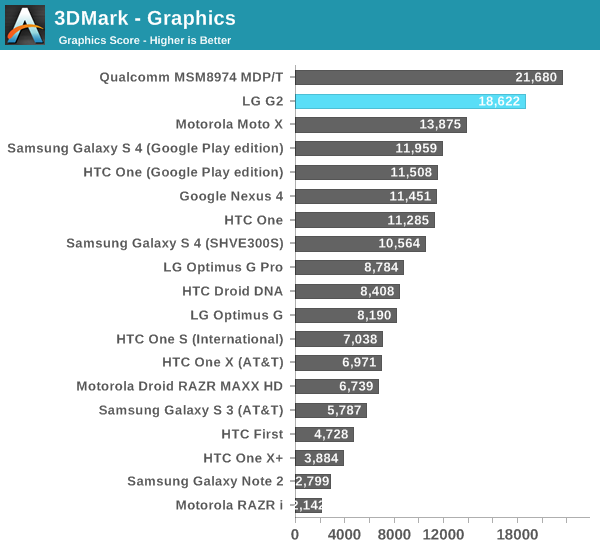
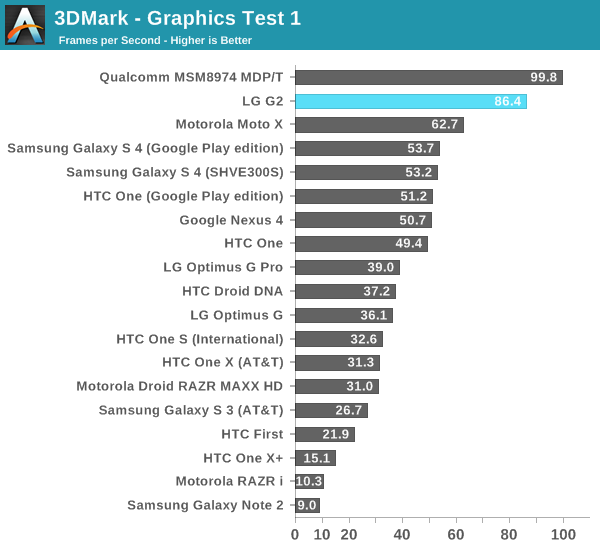
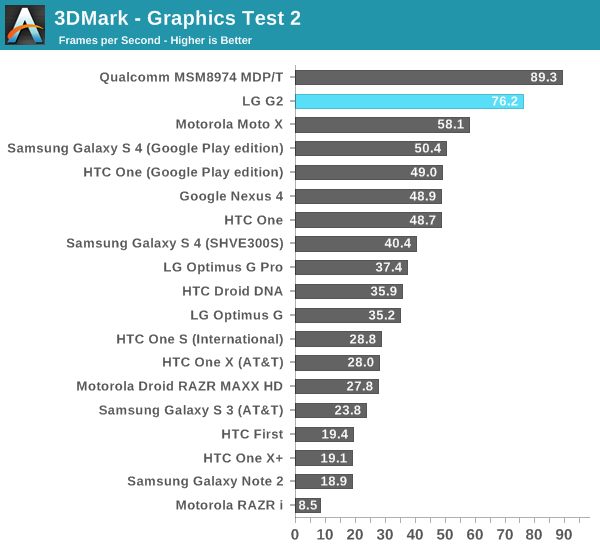
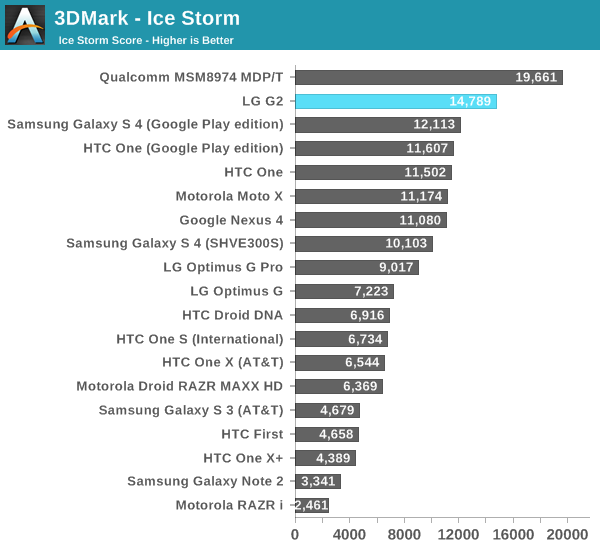
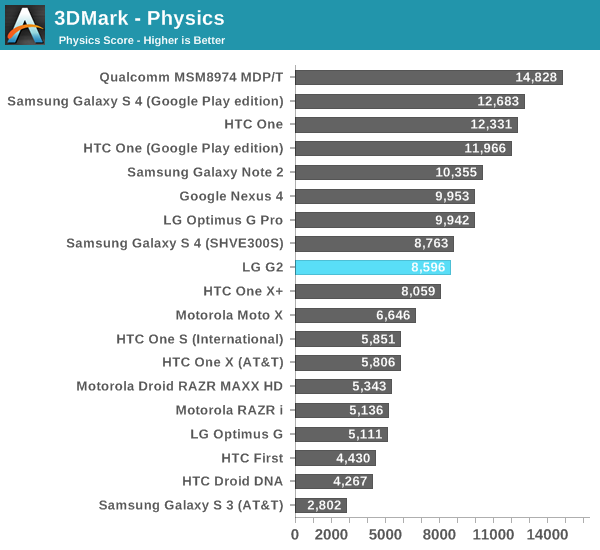
GFXBench 2.7
GFXBench (formerly GLBenchmark) gives us some low level insight into these platforms. As usual, we'll start with the low level tests and move onto the game simulation benchmarks:
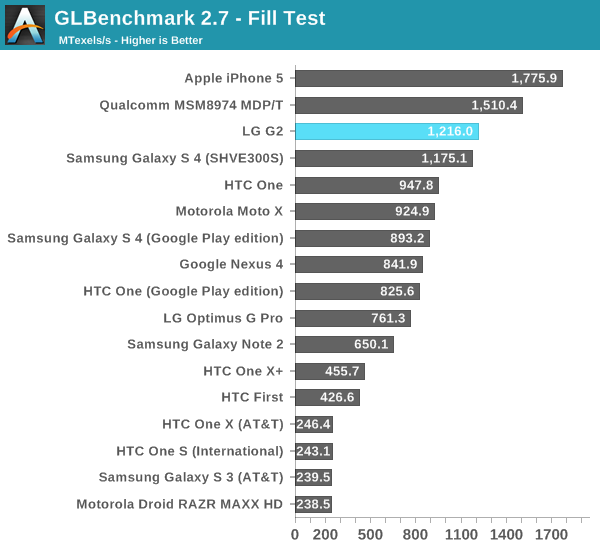
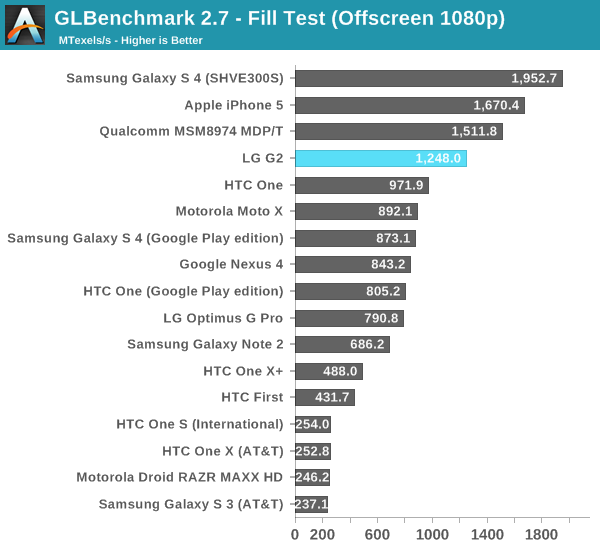
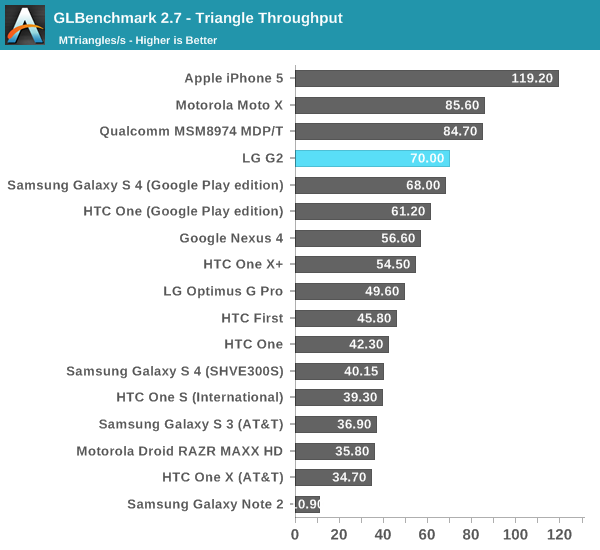
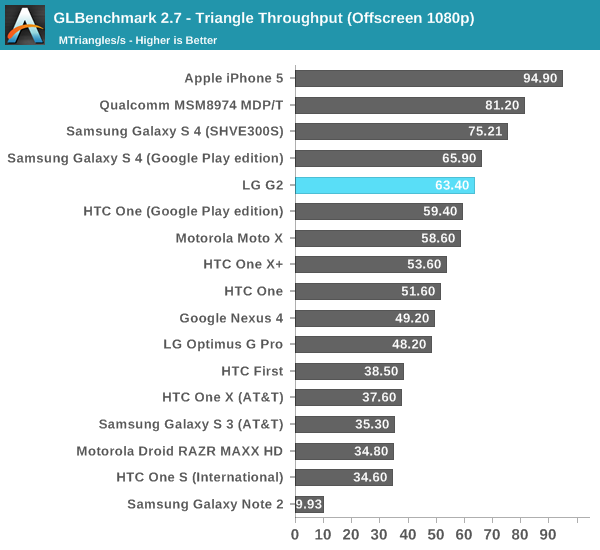
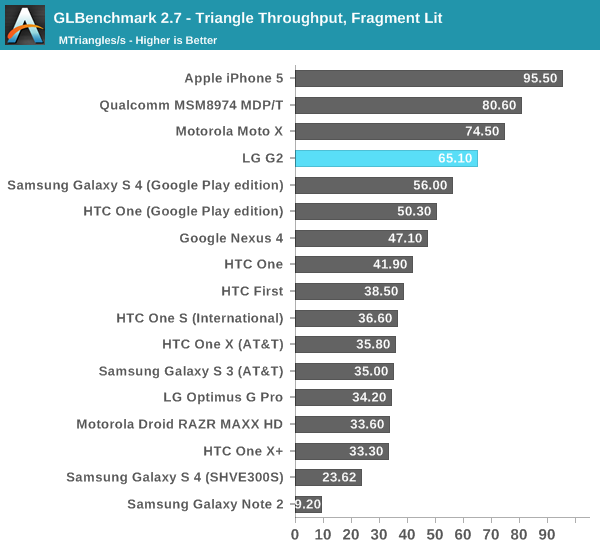
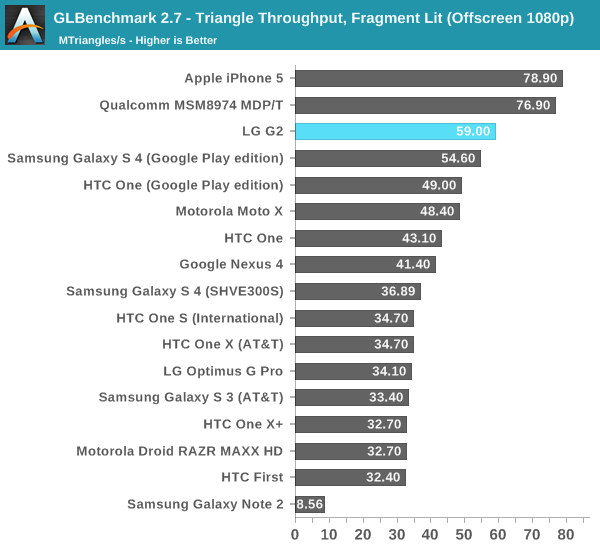
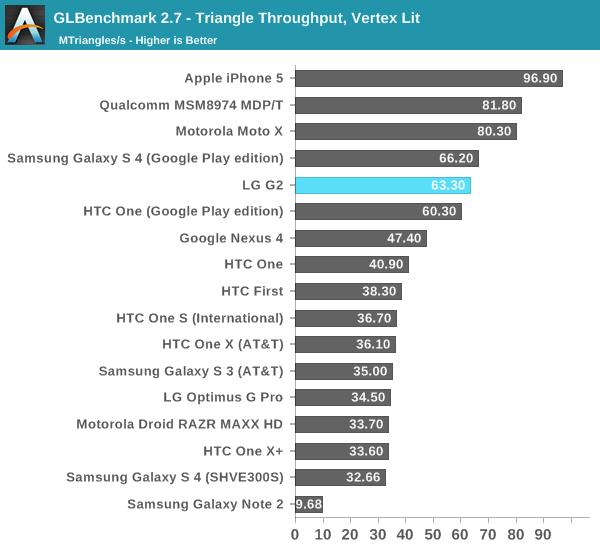
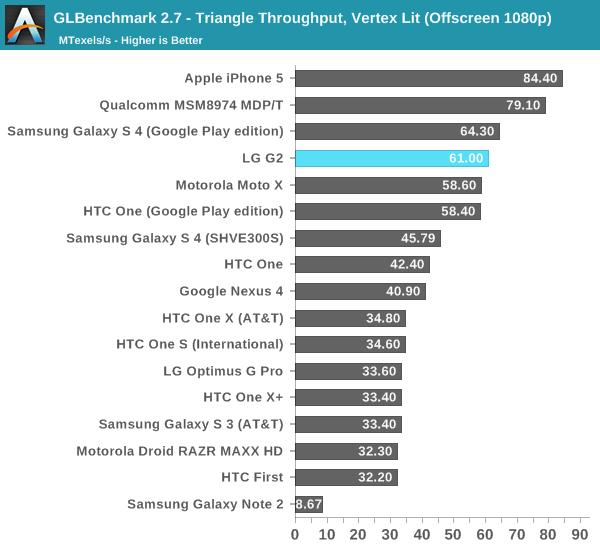
The low level tests put the G2 closer in performance to some of the Snapdragon 600 based devices than the MDP/T, again early software at work here. The T-Rex HD performance looks pretty good, putting the G2 between the S600 devices and S800 MDP/T.
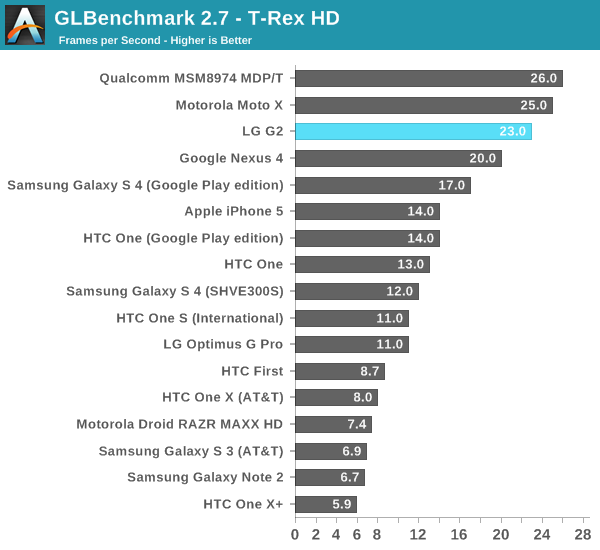
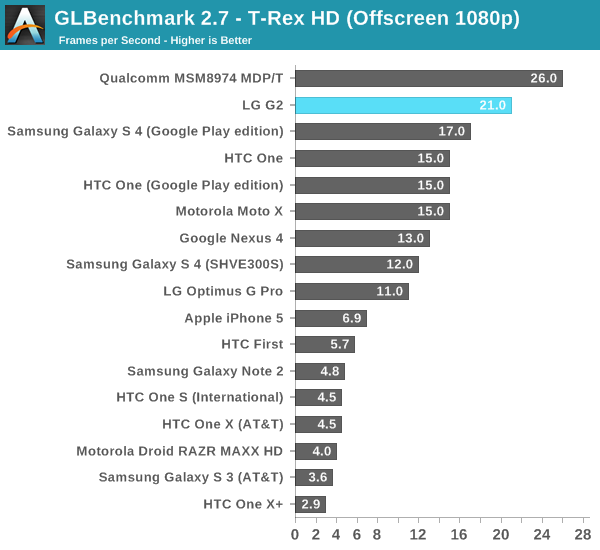
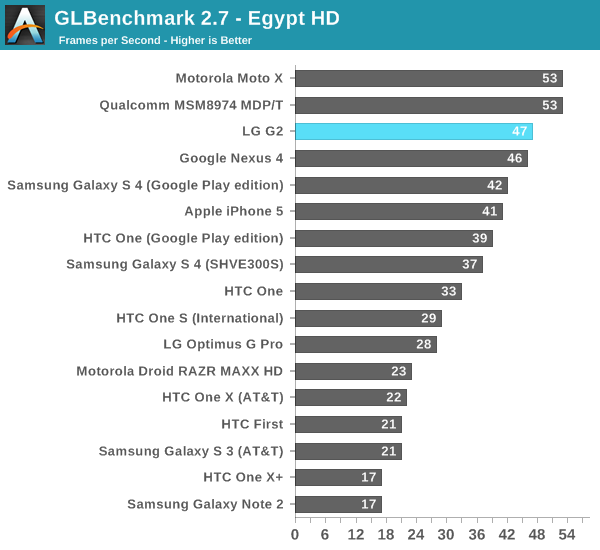
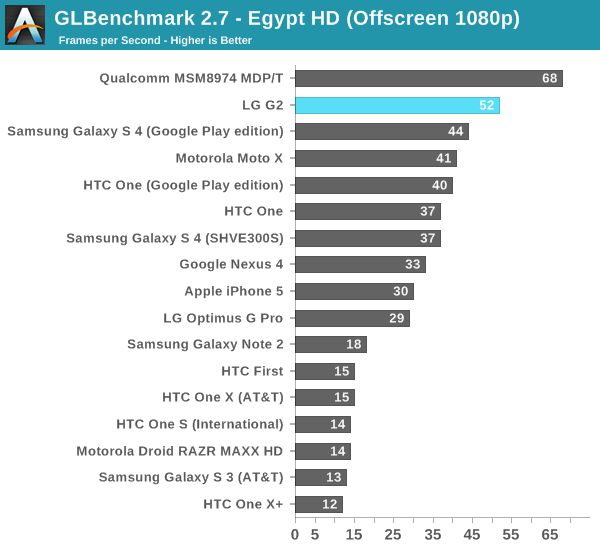
Basemark X
Basemark X is a new addition to our mobile GPU benchmark suite. There are no low level tests here, just some game simulation tests run at both onscreen (device resolution) and offscreen (1080p, no vsync) settings. The scene complexity is far closer to GLBenchmark 2.7 than the new 3DMark Ice Storm benchmark, so frame rates are pretty low:

Basemark X performance tracks with what we saw in the GFXBench T-Rex HD test. Performance is clearly higher than on any other device, but not quite up to MDP/T levels. I wonder how much closer the final device will get.
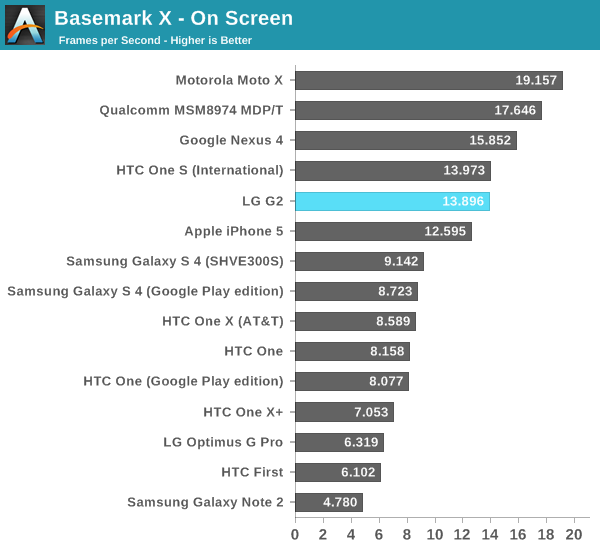
Epic Citadel
Epic's Citadel benchmark gives us a good indication of lighter workload, v-sync limited performance at native resolution. At 1080p, the Snapdragon 800 MDP/T offers over 50% better performance than the Snapdragon 600 based platforms. Granted we're comparing to smartphones here so there's some thermal advantage playing to the 800's favor.
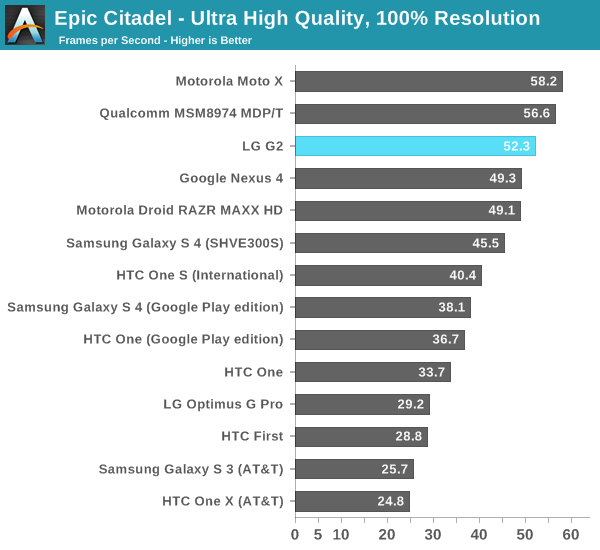










120 Comments
View All Comments
ijozic - Saturday, September 7, 2013 - link
Would love to see some audio quality tests and a comment on the volume levels (maybe in the full review?) as LG usually goes below average in this area..Impulses - Saturday, September 7, 2013 - link
SecondedBoneAT - Saturday, September 7, 2013 - link
It's interesting that the G2 either slightly over-exposes most situations, or the dynamic range is tighter than on the S4 Octa's Exmor RS and or the Lumia 1020, this applies to photos and videos alike. Otherwise I'm highly impressed with the camera performance, very natural, even slightly under-saturated results like the S4 Octa (which in the 808 comparison shows that it's everybody else over-saturating), I'd only set half a step lower exposition correction and let everything else done by the device.Brian, what is the maximum exposure time you could get automatically or manually off a single shot? What is the highest ISO value?
Jon Tseng - Saturday, September 7, 2013 - link
Hmmm. So looks like trade off vs Nexus 5 (2300mah) will be great battery life vs OS updates. Tough one!On rear buttons I'm cool w that -used to have atrix w rear power button/fingerprint and no probs at all w day to day use.
andykins - Saturday, September 7, 2013 - link
Don't forget the biggest difference (imo): price. The Nexus 5 should be around half the price.Alketi - Saturday, September 7, 2013 - link
This actually bodes *very* well for the Nexus 5, as it also packs a Snapdragon 800 chipset.It's not too much of a stretch to expect better battery life than the Nexus 4, which was already decent. Plus, there's a good chance of an upside surprise, if it also packs the panel self-refresh and gets gains from Android 4.4.
Spunjji - Monday, September 9, 2013 - link
One thing worth bearing in mind is that even with ~75% of the battery capacity the G2 would still have class-leading battery life. So, the Nexus 5 is hardly going to stink in that regard!Krysto - Saturday, September 7, 2013 - link
Great to see those battery efficiency improvements from Qualcomm. You'd following the right path here, Qualcomm. Please don't change.Nvidia is stupid for following the "pure performance" path. That strategy has lost them most customers, especially since they followed that strategy to the point where they were making only "tablet chips", which is code-word for "our chips aren't efficient enough for smartphones".
I've said it before, chip makers should think about making "smartphone chips" first and foremost, and THEN, use the same chips, maybe with a little extra clock speed in tablets, too. If think think about making "tablet chips", they will blow it, because they will make the chip too inefficient and won't be able to "downscale" as easily to put it in smartphones.
So yeah, Qualcomm please continue doing your own thing. If Nvidia, Samsung and others keep following the "performance/benchmark" path, then the joke is on them, and will ultimately fail (as they have so far, and it's most devices are using Qualcomm's chips). I do hope they wake up to it sooner rather than later though, because I don't want Qualcomm to become another monopolistic Intel.
UpSpin - Saturday, September 7, 2013 - link
Qualcomm is the only Android SoC producer which does design their own cores and does not rely on ARM finished CPU designs.If you take a close look, you'll see that the Tegra 4 and the Exyons 5 are the only A15 processors at the moment, and it probably took much longer for ARM to release them and for NVIDIA and Samsung to finalize them than expected. They also had no other option than A15 to get some improvement over A9 and to remain competive with future Qualcomm SoCs.
Qualcomm on the other hand was able to release minor updates the whole time, so processors between A9 and A15.
Samsung will do the same next year, so expect some larger competition to Qualcomm.
Qualcomm also has the big radio advantage, which NVIDIA adressed with the i500 and which might make them competive to Qualcomm next year again.
Neither Samsung nor NVIDIA followed a performance strategy only. They had no other choice than using A15, and Tegra, as always used their 4+1, Samsung had to use big.LITTLE to make A15 usable in a smartphone. But big.LITTLE wasn't fully ready yet, so they had no other choice than using an octa-core setup.
And also remember that MIPS (a competive contender to ARM, but so far mostly used in low end applications) got bought up by Imagination Technologies, which I strongly believe will try everything they can to push MIPS in the high end sector.
So I think it's safe to assume that there won't be a monopoly, Qualcomm just had a big advantage for one year because of the A9 to A15 gap and by offering integrated radios. Both Samsung and NVIDIA learned from this, and a new competitior to ARM is coming up, too.
So it will get really interesting.
Impulses - Saturday, September 7, 2013 - link
That one year advantage in design turned into two solid years of device wins for Qualcomm tho... It's gonna get interesting next year for sure.